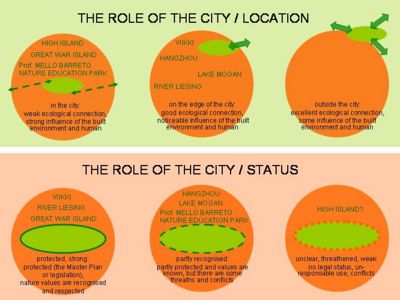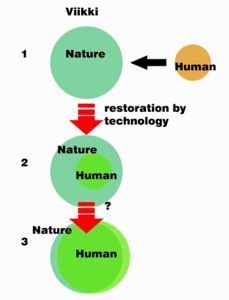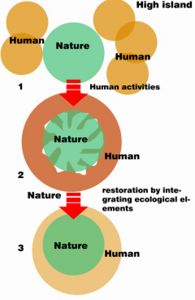Working Group Nature Conservation: Difference between revisions
| Line 106: | Line 106: | ||
So we see that the recent ecological politics can, on one hand, take part to re-structuralism of natural sites in urban process, with the difficulties about sharing uses and objectives. On the other hand, these politics are motors of natural planning in urban process, showed by the Eco-district system, as the one of Viikki, and use nature as an element of construction, seen as a recreational and ecological item. | So we see that the recent ecological politics can, on one hand, take part to re-structuralism of natural sites in urban process, with the difficulties about sharing uses and objectives. On the other hand, these politics are motors of natural planning in urban process, showed by the Eco-district system, as the one of Viikki, and use nature as an element of construction, seen as a recreational and ecological item. | ||
<gallery caption=" " widths=" | <gallery caption=" " widths="300px" heights="300px" perrow="5"> | ||
Image:Evolution_of_Viikki_copy.jpg|Evolution of Viikki | Image:Evolution_of_Viikki_copy.jpg|Evolution of Viikki | ||
Image:Evolution_of_great_war_island_copy.jpg|Evolution of Great War Island | Image:Evolution_of_great_war_island_copy.jpg|Evolution of Great War Island | ||
Revision as of 12:06, 12 January 2009
Case Studies of this working group
The list includes all case studies categorised in this group and the respective answers to the first question "Rationale:Why is this case study interesting?"
Attention: this is a dynamic page list, do not edit this paragraph!
<DPL>
category=Working Group Nature Conservation mode=ordered include = #Rationale: Why is this case study interesting?
</DPL>
Core Questions of this Working Group
Core themes (as identified on 3rd of December 2008):
- User group
- City
- Urban nature
- Interaction
- Water
Core questions
- What is the role of user groups? (Emel)
- What is the role of the city? (Virpi)
- How do urban and natural structures interact? (Urban nature interaction, Daliborka and Jovana)
- What is the role of water? (Barbara)
Notes:
- The names behind the questions identify those people that take up a kind of editor's responsibility for the questions. All group members are asked to integrate all questions into their case study report. The respective question editors will then compile the different answers and report back to the group plenary on December 19th.
- People who did not attend the session on 3rd of December may have additional proposals for core questions. Feel free to add these questions as proposals to the list above and discuss it via e-mail or using the discussion page.
- Please integrate the questions soon and try to deliver some draft answers before December 15th - otherwise it will become difficult to create a synthesis report for December 17th.
Synthesis of Core Questions
What is the role of user groups?
Emel
<DPL>
category=Working Group Nature Conservation mode=ordered include = #What is the role of user groups?
</DPL>
What is the role of the city?
Answers of the Case Studies
<DPL>
category=Working Group Nature Conservation mode=ordered include = #What is the role of the city?
</DPL>
Collaborative Synthesis (Virpi)
How do urban and natural structures interact?
Urban nature interaction, Daliborka and Jovana
<DPL>
category=Working Group Nature Conservation mode=ordered
include = #How do urban and natural structures interact?
</DPL>
What is the role of water?
Barbara <DPL>
category=Working Group Nature Conservation mode=ordered include = #What is the role of water?
</DPL>
What is the evolution of the urban relation between humans and nature?
Anwers of the Case Studies
Lolita & Chinyi <DPL>
category=Working Group Nature Conservation mode=ordered include = #What is the evolution of the urban relation between humans and nature?
</DPL>
Collaborative Synthesis
The relationship between nature and human can be always described either harmonious or conflicted.
The nature, exist as the fundamental base for human activity,always follow its own biological evolutional step in absence of the effect from human. However, since human beging initialized the dominant status among all the "organisms" live in the globe. The activities significantly affected the nature, either in a positive way, or reverserly, negative way.
In all case studies, attempts were made to soften the relationship between nature and human given that our era just located in the very moment, when nature system (ecological system) has been broken extensively. Anyway, since the close attachment of city, the city, the population explotion, the conflict between nature and human is more and more severe. We tried to use relativly mild measure,make it possible for the nature to survive its evolution, meanwhile also serve as a functional (recreational or productive) site for human being.
As a part of the process of relation between humans and Nature, we can see in all these case studies that we have three great ways of treating it in the landscape projects: First we have the relation with the huge elements of nature: Lake, mountain, rivers, forests... (Great war Island, Hangzhou, High Island, Lake Morgan, River Liesing) The answers in these cases are often first to use it as a resource item, then to include it as a part of the city and finally to restore its ecological value (due to the actual politics).
Often, we have the case of a natural element part of a urban process (High Island, Lake Mogan, Parque de Educaçao Ambiental Mello Barreto, River Liesing). These projects are often seen as recreational system, as well as a biodiversity item. We can see here the difficulties of the cohabitation, as reported by the Lake Mogan experience. High Island could be one of these not successful experience, as the politics's aims were too numerous (recreational, esthetical, ecological...)
Then we have the example of Viikki, which is the typical example of the Nature seen as an element of construction of the project. This modern way of built is a new form of the garden-cities, with an ecological politic. This conception of relation between nature and humans is full of technical solutions, presented as perfect answers to ecological problems. However, we still have few reports back from these experiences, and as an experience, we can't really say that is the miracle system to use every time.
In the case of Hangzhou,which the interaction between human and nature was comparatively detailed record,we can observe all kinds of measure taken to improve the relationship between city, human, and nature( lake).However, up to now,the traditional technique maintain the most fequently used measure in this project. The ultimate goal, in which people and nature can coexist without frequently amendation and restoration, remains pending.
So we see that the recent ecological politics can, on one hand, take part to re-structuralism of natural sites in urban process, with the difficulties about sharing uses and objectives. On the other hand, these politics are motors of natural planning in urban process, showed by the Eco-district system, as the one of Viikki, and use nature as an element of construction, seen as a recreational and ecological item.
Working Group Minutes
First Meeting
- Minutes First Meeting WG 2, 3rd of December 2008



